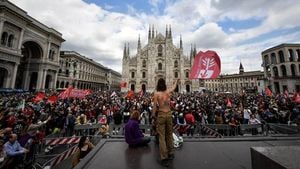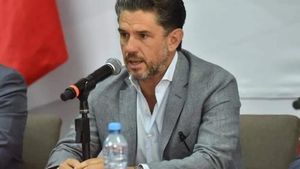Hurricane Milton has left Florida reeling, causing extensive destruction and flooding across the state. Days after the storm's catastrophic landfall, communities are grappling with the aftermath, which has been punctuated by tales of survival, loss, and the incredible impact of nature's fury.
CAPE CANAVERAL, Fla. (AP) — On Friday, four astronauts returned to Earth after spending nearly eight months aboard the International Space Station, their return delayed due to issues with Boeing's Starliner capsule and the relentless forces of Hurricane Milton. A SpaceX capsule successfully delivered them back to the Gulf of Mexico early Friday morning, just off the Florida coast. Initially slated to return two months prior, their homecoming was postponed by mechanical failures and the looming threats posed by the hurricane.
The astronaut crew, which included three Americans and one Russian, faced unexpected delays, not just from technical problems but also from the severe weather caused by Hurricane Milton. While these astronauts were suspended in the delicate balance of space, Florida was preparing for what would become one of the most powerful storms to hit the region. The hurricane had intensified to Category 3 status before making landfall near Siesta Key, bringing with it winds reaching up to 124 mph (200 km/h).
Across Florida, communities were not only bracing for the hurricane's impact but were also dealing with tornadoes spawned by the storm, which wreaked havoc on residential neighborhoods far from the coastal areas. Crystal Coleman, for example, shared her distressing experience from her home in St. Lucie County, which was ravaged by one of these pre-landfall tornadoes. "All of a sudden, the door to my attic flew off, and all the objects inside started flying around," she recounted to BBC News, conveying the terror felt as the tornado seemed to engulf her home. Tragically, the storm has claimed at least 16 lives across the state, with officials warning the death toll could rise as more assessments are conducted.
Meanwhile, communities tore through the wreckage left by Hurricane Milton, with swirling fears about safety and loss permeated through the air. At the storm's peak, it brought heavy rainfall, with some areas seeing up to 18 inches (45 cm). Streets were transformed by floodwaters, uprooted trees, and debris scattered everywhere, creating overwhelming scenes of destruction. Power outages left many without electricity and running water, and emergency services scrambled to assist those most affected.
Florida Governor Ron DeSantis reported significant evacuations, advising around 80,000 residents to leave their homes before the storm made landfall. Fortunately, many heeded such warnings. "My sense is a lot of the people did leave who were in the evacuation zones," DeSantis stated, empathetic to the plight of those still enduring the storm's impacts.
Nevertheless, rescue efforts continue. Emergency responders and volunteers have been tirelessly working to assist those stranded or displaced. Over 400 individuals alone were rescued from severely flooded areas, including apartment buildings inundated with water. Helicopters and large vehicles facilitated these rescue missions as the storm passed and roads became navigable once again.
The storm also left its mark on the agricultural sector, as crops were washed away and entire fields submerged. Farmers are worried about the long-term impacts on their livelihoods, as they begin assessing damage and calling for relief. Local organizations have rallied to help feed displaced families, offering hot meals and smiles amid the chaotic aftermath.
On the West Coast, residents like Maria Bowman braced themselves as the hurricane approached. She shared her experience of her mobile home trembling as Milton roared ashore. "It sounded like an explosion; boom! No electricity," she described, emphasizing the sheer power of the storm. Bowman, having weathered multiple hurricanes before, expressed her uneasiness, stating, “It’s too many hurricanes… one day you survive it; the next time, who knows.”
Across the state, cities like St. Petersburg experienced considerable damage. Areas were left without power, and baseball stadiums were torn apart. The home of the Tampa Bay Rays, for example, suffered damage to its dome, symbolizing not only the physical destruction but the emotional toll each storm brings to communities. Mayor Jane Castor of Tampa noted the sheer scale of recovery efforts needed, which have only compounded after experiencing another storm so soon after Hurricane Helene.
Despite the challenges, residents remain resilient, facing uncertainty with determination. Bob Viola, who also weathered the previous storm, remarked on the emotional weight of enduring back-to-back hurricanes. “I don’t know what will happen here. I really don’t,” he said, reflecting the unease felt by many who must contemplate future storms after such fresh trauma.
Hurricane Milton stands as another reminder of the power of nature and community resilience. The aftermath of its fury is still being assessed, with the Florida government and FEMA mobilizing resources to assist those hardest hit. A long road to recovery lies ahead, but the strength of the Sunshine State's community continues to shine through the darkness left by the storm. Reports indicate the continued need for assistance and vigilance as remaining floodwaters recede and the inspection of homes becomes accessible.



